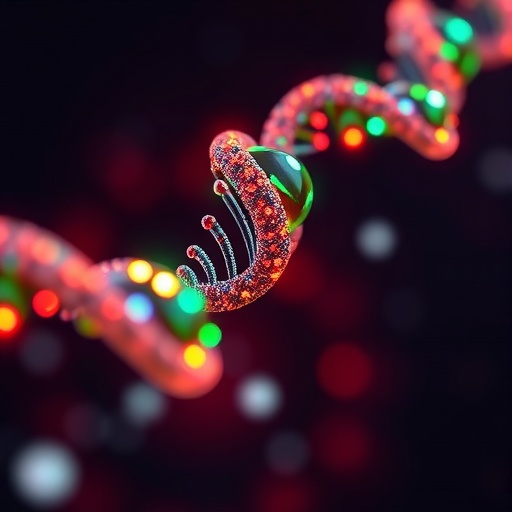In a groundbreaking advancement at the frontier of synthetic biology and molecular computing, researchers have unveiled a novel reusable DNA-based circuit architecture that significantly elevates the capacity for heat-rechargeable computation. This innovative system leverages the fundamental properties of DNA strand displacement to construct logic gates and neural networks capable of repeated reset and function, introducing a new era of sustainable, robust molecular information processing.
Central to this breakthrough is an ingenious threshold mechanism that operates with remarkable precision by exploiting specific concentration dependencies. Unlike traditional annihilator mechanisms commonly applied in winner-take-all neural networks, the threshold effectively distinguishes input signals based on their magnitude—sub-threshold signals are selectively suppressed, while those exceeding the threshold are amplified. This selective thresholding enables the restoration of noisy analog inputs into discrete, reliable digital outputs, thereby vastly improving signal fidelity and paving the way for more intricate computational tasks.
Delving deeper into the engineering of reusable thresholds, the research presents two innovative designs: a hairpin structure and a compact two-stranded complex. Both designs demonstrated promising functionality; however, slight performance degradation was observed after resetting, a process critical for reuse. To address this, the researchers carefully fine-tuned the reset conditions, particularly focusing on less sensitive circuit components, with the aim of striking an optimal balance between performance retention and reset efficiency.
The authors identified an optimal reusable catalyst design featuring a 7-nucleotide loop toehold and no bulge, which bolstered the reset performance of upstream hairpin gates operating at higher temperatures. This refinement allowed more gate strands to re-engage in essential strand displacement reactions, facilitating the correction of undesirable waste products that accumulate during operation. As a result, the circuitry showed sustained performance even after multiple reset cycles, a vital characteristic for scalable molecular computing.
Extending this architecture, the team implemented reusable logic gates incorporating signal restoration capabilities—a hallmark of digital systems aiming to maintain robust outputs despite analog input variability. The two-input logic gates demonstrated precise control over threshold behavior, enabling the construction of both OR and AND logic functions. Notably, each input signal was connected to upstream hairpin gates and associated fuel strands, ensuring input inactivation did not interfere with the reset process of the summation gate, thus preserving the circuit’s overall integrity.
Beyond individual logic gates, the researchers tested the composability of these modular components by designing and fabricating a three-layer DNA circuit capable of computing the first sixteen elements of the infinite Fibonacci word. This binary sequence, renowned for its rich combinatorial properties, was implemented using feedforward logic with carefully orchestrated input signals that encode the computational round index. The design adhered strictly to a fundamental architectural rule mandating an alternating pattern between hairpin and two-stranded gates, a strategy that proved effective in maintaining consistent computational performance.
This logic circuit employed a dual-rail encoding technique to represent each signal as complementary on and off states, transforming each logic gate into a combined entity encompassing its upstream NOT gates alongside the requisite AND and OR gates. Such innovation mitigated complexities arising from signal fan-out and input sharing, ensuring scalable and predictable circuit behavior across computation layers. The comprehensive DNA network comprised five distinct molecular species, coordinated in a precise topological and kinetic framework to facilitate accurate information processing.
Crucially, long-term empirical evaluation underscored the durability and reliability of the system. Over a sustained period of 640 hours and fifteen repeated resets, the seven-layer DNA circuit maintained consistent performance, with experimental results closely mirroring computational simulations. Minor divergences between predicted and observed behaviors were attributed to sequence-specific variations and fluctuating effective concentrations within different circuit components, underscoring the intricate interplay between molecular design parameters and functional output.
Significantly, this study transcends the limitations of previous DNA computing paradigms by introducing heat-based reset protocols that cleanse molecular circuits without compromising ongoing informational integrity. The heat-rechargeable feature elegantly addresses the perennial challenge of waste accumulation in strand displacement systems, enabling repeated reuse and thereby enhancing the practicality and sustainability of DNA-based computing for real-world applications.
Moreover, the architecture’s modularity and reliability open avenues for constructing increasingly complex molecular networks, providing a robust platform for deploying DNA logic systems in biosensing, diagnostics, and nanoscale robotics. By enabling layered computation and signal restoration, the research paves the way for molecular circuits that mimic neural network architectures, potentially contributing to the emergence of biologically inspired computing devices with adaptive learning capabilities.
The implications of this work extend beyond synthetic biology into the broader realms of computation and materials science. Heat-rechargeable molecular circuits exemplify a new class of programmable matter, where information processing can be dynamically controlled and renewed within soft materials. This integration of computation and materials heralds future innovations in smart therapeutics, environmental monitoring, and responsive nanomachines that leverage the inherent programmability of DNA.
As molecular computing continues to evolve, this landmark achievement underscores the power of chemical kinetics and thermodynamics to design intrinsically reconfigurable systems. By harnessing the thermostability and strand displacement dynamics of DNA, the researchers provide a blueprint for scalable, sustainable, and exquisite control over molecular information flow that may ultimately transform technological approaches in both healthcare and computing sectors.
In sum, the development of reusable, heat-rechargeable DNA logic circuits and neural networks represents a paradigm shift in molecular computation. This work not only surmounts practical hurdles related to circuit reset and waste removal but also equips biological computing with potent tools for accurate, multi-layered, and long-term operation, inspiring new directions in the integration of synthetic biology and information technology.
Subject of Research: DNA-based molecular computing and reusable logic circuit design
Article Title: Heat-rechargeable computation in DNA logic circuits and neural networks
Article References:
Song, T., Qian, L. Heat-rechargeable computation in DNA logic circuits and neural networks.
Nature (2025). https://doi.org/10.1038/s41586-025-09570-2
Image Credits: AI Generated




